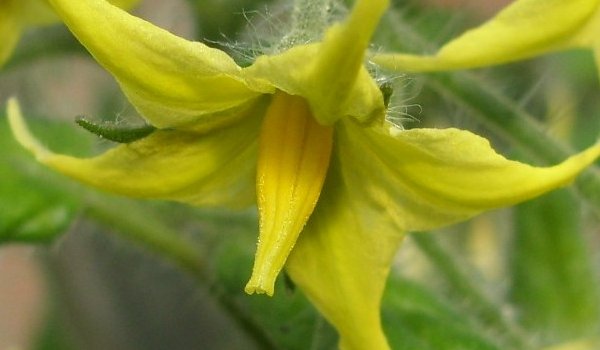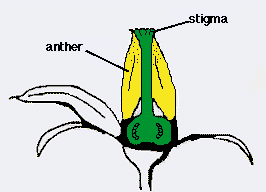One of the big frustrations for tomato growers at this time of the season is when flowers fail to pollinate and abort from their plants.
It can happen for all sorts of reasons – here are a few below …
Pollination
Tomatoes flowers are self-pollinated and this occurs mainly between 10 am and 4 pm. However, In order for flowers to set fruit, temperatures need to be within a given range.
If night time temperatures drop much below 10C or 50F, pollen fails to develop and flowers will not set fruit.
Early Season Varieties
Some varieties cope better with lower temperatures than others, for example, the early season varieties tend to set better at low temperatures than mid or late season varieties.
Cold Nights
Cold nights in the early part of the season often prevent fruit set and cause a delay – flowers stay un-pollinated for a longer period than usual. This sometimes results in dry set – the flower dies away but there is no appearance of fruit.
Hot Days
If the daytime temperature reaches around 32C (90F) before noon, blossoms that opened that morning may abort. This can happen in a conservatory, greenhouse or polytunnel if temperatures soar.
Some varieties are able to cope with higher temperatures better than others, but the ones we grow in the UK are mainly early to mid season and are better able to cope with lower rather than higher temperatures.
High Output
When temperatures remain within the favourable range in early summer, tomato fruit set may be unusually high and bush varieties produce more flower clusters than usual. If a plant has to support a high number of set fruit, tomatoes may ripen smaller than expected. There have been times when I’ve had to remove flower buds from bush varieties because it would have been unrealistic to expect a plant to produce so many fruit.
As you can see from the above, blossom drop and reduced fruit set can be difficult to avoid in some circumstances!

Pollinating Outside and Inside
When growing outside, pollination often occurs due to wind movement and insects. In greenhouses and polytunnels, where there is little or no air movement, it’s good to manually shake individual flower trusses or entire plants to release of pollen.
 Professional growers uses bumble bees. The bumble bee vibrates its wings and causes the whole flower to vibrate – a cloud of pollen is then released onto the bee’s body and onto the stigma and the flower is pollinated.
Professional growers uses bumble bees. The bumble bee vibrates its wings and causes the whole flower to vibrate – a cloud of pollen is then released onto the bee’s body and onto the stigma and the flower is pollinated.
An electric toothbrush, is also useful for this purpose.
The photo on the left shows the male part of the flower – the anther – where the pollen is made, and the stigma, female part, where the pollen enters and travels down to the overy.
Other reasons why flowers may fail to pollinate include …
- Nitrogen levels too high or low
- High or low humidity
- Water stress
- Windy conditions
- Low light levels
- Excessive pruning
After all that, it is a minor miracle that flowers produce fruit at all!
Extending The Fruiting Period Of Bush Plants
One reason why some gardeners won’t grow bush tomato varieties is because bush plants produce fruit over a relatively short period – compared to tall indeterminate plants.
However, it is possible to extend the fruiting period.
Feeding high potash feed to bush varieties when plants come into flower/fruit is common practice because it promotes the reproductive stage and early ripe tomatoes. The thing is though – it also brings plants to an early finish.
This may be good in a poor summer, or in a short season area because it pushes plants along to produce more quickly.
However, if you would like a bush variety to produce at a slightly slower rate, but over a longer period, this can be done by feeding with a balanced feed when fruiting begins rather than a tomato feed that is high in potassium.
Some bush varieties also produce a second flush of flowers and fruit if conditions are good and they have been fed with a balanced feed.
That’s it for this week … I hope all is well in your garden!
Regards,
Nick

Jill Barber
Very informative Nick.
I’m a newbie, having a couple of plants; Lilliputian F1 and Yellow pear heirloom in a container. Lots of flowers but they seem to shrivel without creating fruit. It’s warm this year even at night, I’m daily watering and have just started feeding a month after repotting. What’s happening?
Nick
Hi Jill,
What size containers are you using?
Are you planting in new or old soil?
Do the leaves look healthy – any unusual marks?
Nick
Jill Barber
Hi Nick ,
The container is around 30cm, I transferred them both into this with John Innes No3.
Leaves look healthy. One of my neighbours gave me the plants a month ago.
Thanks
Jill
Nick
Hi Jill,
You are doing everything right!
It sounds like blossom drop.
In hot weather, when humidity is either very high or very low, flower set can be a problem. Flowers fail to set as pollen is too dry to fertilize a flower’s ovary.
In dry air conditions – low humidity, pouring water on the greenhouse floor or around the base of a plant can help.
When the air is high in moisture, tapping plant stems to help dislodge and move pollen around, inside the flowers can help too.
Jill Barber
Thanks Nick,
I’ve been shaking the blooms and also occasional sprays. Fingers crossed.
Jill
Sharon
Great, informative post, Nick. Thank you! We’re into June gloom here in Southern California, and I’m on the coast, but so far, so good. Tomato plants flowering, and some fruiting well. All, about ten plants, are open pollinated and heirlooms, one a Beefmaster hybrid.
Rhys Jaggar
Great summary this Nick, a gold mine of information all on one page. Particularly about the use of balanced vs tomato feed during flowering.
So far fruit set here on the March sowings has been quite good up here, particularly Alicante, Tigerella and Super Marmande, with fruit established on three trusses for each. All strains have at least two tomatoes set now, except the April plants which do not yet have a flower.
I must say this year plants from a March 10 sowing are very well advanced. I have six trusses created on a single Tigerella cordon, which means I should have enough trusses to stop by the end of June. Alicantes are similarly precocious. It would be great to have all fruit set by July 15 to see if that means all will ripen on the vine before late September. I have always felt this to be the optimal outdoor timetable, but have usually struggled to get there. Perhaps my growing has finally reached the required standard?
Nick
Hi Rhys, I’m pleased you found the summary helpful – I think that you have reached the required standard.